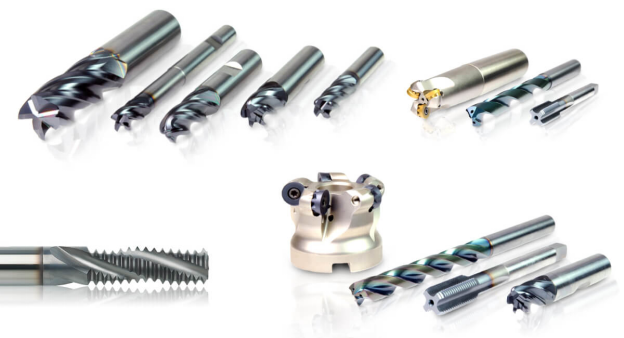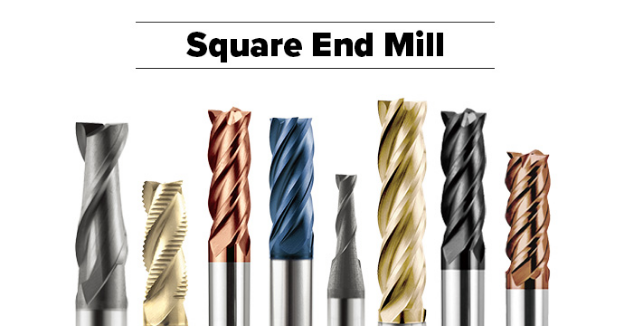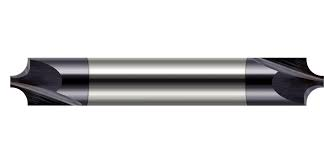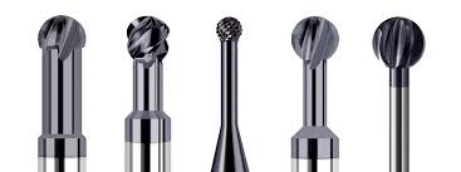Milling Machine Cutting Tools: Types, Functions, and Selection Guide
 Feb 07,2025
Feb 07,2025

We are sure you have seen many components with difficult shapes daily. These components are used in many applications such as in turbine blades, engine blocks etc. You wonder how these components are made. A CNC milling machine is used to manufacture these components. Milling tools are used to machine the components of this machine. This article is about these milling tools, their types and uses etc.

What Are Milling Cutters and How Are They Used?
The introductory section of this article:
What Is a Milling Cutter?
As I discussed earlier, a milling machine uses many milling cutters to machine a component. These milling cutters are objects with sharp edges which remove excessive material in the form of chips to turn it into the desired shape. Face mills, slab mills, drills etc. are the common milling cutters.
Overview of Milling Machine Cutting Tools
Its working mechanism is simple. You just push the cutting tool into the workpiece and then you move it in that direction where the material must be removed. An end mill is an example of milling tools, which remove material using the tip instead of the sides.
13 Different Types of Milling Cutters
Till now, I mentioned just one cutting tool. In this section, you will learn about other milling cutter tools.
- Face Milling Cutter
- Multiple teeth are engraved on this type of milling cutter
- Provides efficient surface finish
- Ideal for large surface
- Slab Mill Cutter
- Cylindrical body with sharp peripheral cutting edges
- Used for bulk material removal
- Specially designed for horizontal milling machine
- T-Slot Cutter
- Used to machine "T-shaped" slots
- Used to employ bolts and fasteners etc.
- Thread Mill
Used for:
- Thread-cutting operations
- Creating internal or external threads
- Machining difficult materials
- Chamfer Mills
- Helpful in creating a bevelled edge
- Designed for chamfering and deburring edges of workpieces
- Enhance the functionality and aesthetics
- Gear Milling Cutters
- Gear cutting tools used for milling machine of gears
- Used to create complex tooth profiles efficiently
- Used for Involute gear forms
- Radius and Hollow Milling Tools
- Use for creating rounded edges
- Best for machining hollow sections
- Use it for aesthetic and functional curves
- Ball Nose Cutter
- Also known as a ball end mill
- The hemispherical shape of the cutting tool
- Used for 3D surface machining, mould making, and machining complex curves
- Side and Face Cutter
- Cuts the sides and surface of the workpiece simultaneously
- Ideal for slotting and surface machining
- Offers versatility in milling applications
- Roughing End Mill
- Contains serrated teeth to improve cutting efficiency
- Designed for rough-cutting operations
- Allows rapid material removal
- Woodruff Cutter
- Possess a flat bottom with a semi-circular profile
- Specifically used for machining Woodruff key slots
- Used for components i.e. gears and shafts
- Involute Gear Cutter
- Specifically designed for creating involute gears
- Responsible for producing tough geometry for power transmission in gear systems
- Dovetail Cutter
- Used for machining dovetail slots
- Commonly used in jigs and fixtures
- The design provides a secured workpiece holding
Types of Mill Bits for CNC Machines
Multiple mill-bit types are available in which Square, round, and ball end bits are common.
Square End Bit
- Featuring a flat cutting end
- Provides efficiency in machining flat surfaces and slots
- Also used for deeper cuts
Round End Bits
- As the name shows, these mill bits come with a round end
- Helpful in creating contours and intricate designs
- You can use these bits when the applications require rounded edges or a higher surface finish
Ball End Bits
You can manufacture 3D contours, moulds, and complex curves easily using ball end bits. These bits consist of a hemispherical tip which ensures the reliability of work.
Manual Milling Machine Cutter Types
In this type, multiple operations like face milling or slotting can be performed. Manual milling cutters are used for straightforward milling operations. A common name for manual milling machines is knee milling. It is knee milling because it uses a vertical knee for adjusting up and down the workpiece for machining.
Common Types of Milling Cutters and Their Functions
All the following milling cutters are categorized based on designs and their functions.
End Mill Cutter Types
Some common types of end mill cutters are explored here. So, let's start:
Ball Mill Cutters
You will have seen mould-making in which curved surfaces are required. In that case, ball mill cutters are used. A hemispherical tip at the end of this cutter helps produce round shapes efficiently.
Square End Mills
If you need precise corners and edges in your components, use square-end mills to work efficiently.

Radius End Mills
You can call them corner round-end mills because these tools are specialized for creating rounded edges on workpieces. Such edges are important for aesthetic and functional looks. These tools are specifically designed for deep cuts inside pockets or on the backside of the parts.

Undercutting End Mills
Some areas of the components are not possible to machine with standard milling tools, because these tools can't reach those points. So, undercutting end mills do that job because of their angles and geometries. It produces a high-quality surface finish.

Corner Radius End Mills
If your components have sharp corners, then these components are concerning. Because they contain stress-raiser points which will start generating cracks, so ultimately failure. These sharp edges are blunted using corner radius end mills.
End Milling vs. Face Milling
End Milling
The indexable milling cutters' sides are used for cutting workpieces instead of tips. Best technique for producing pockets and complex components. Vertical and horizontal workpieces are machined using the end milling technique.
Face Milling
This technique produces flat surfaces perpendicular to the spindle, best for finishing steps.
Face Milling Cutters
Have you wondered; About finishing the sides of a step on a rectangular workpiece, which tool we can use? So, the answer is to use face milling cutters. These tools work best for removing bulk material while maintaining a good surface finish as well.
Slab Mill Cutters
These tools are used in climb milling and operate parallel to the workpiece direction. Havier cuts are possible with great speed and efficiency.
T-Slot and Slotting Cutters
T-slot Cutters
Used to remove excessive material to turn it into T-shaped components. Some examples of these tools are an HSS T-slot cutter, an indexable T-slot cutter etc.
Slotting cutters
If you are supposed to make grooves or slots on the components, slotting cutters are used. Common examples include woodruff keyseat cutter, plain slotting cutter etc.
Form Milling Cutters
These tools are customized according to the applications but mainly are used for making profiles on the workpieces. The common types include convex, corner rounding etc.
Fly Cutters
You can use fly cutters for both manual milling and CNC milling operations. It is used to produce plane surfaces and easily machine large and flat components. In manual milling, it is used to achieve good surface roughness and finish.
Milling Tooling and Tool Parts
This section is about the milling tool selection guide.
Anatomy of a Milling Tool
Anatomy of a cutting tool means what is the geometry or structure of the cutting tool. Any milling tool consists of three parts: flutes, helix angles and cutting edges.
Flutes
Spiral grooves are present on the surface of the tool allowing chip removal.
Helix Angles
The angle between the cutting-edge tangents and the tool's centerline. It affects cutting force, vibration and heat generation.
Cutting Edges
The edges which cut or remove the material from the surface of the workpiece.
CNC Milling Tools List
The following table shows the list of main milling tools.
|
End Mill |
Used to perform operations such as plunging and profiling. |
|
Face Mill |
Designed for machining flat surface workpieces, it contains multiple cutting edges allowing superior surface to finish. |
|
Fly Cutter |
Used in both CNC and manual milling machines and produces good surface roughness. |
|
Slab Mill |
Used to remove bulk material efficiently. |
Horizontal Milling Cutters vs. Vertical Milling Tools
|
Horizontal Milling Cutters |
Vertical Milling Tools |
|
Usage: to machine large thick workpieces due to their designs |
Usage: a versatile machine because of drilling, machining complex shapes etc. |
|
Applications: mould making, wings, fuselage machining etc. |
Application: prototyping, custom manufacturing, tools and die making etc. |
Materials for Milling Cutter Tools
Materials with high hardness and high resistance to wear and tear are required to make cutting tools. This section presents some notable materials.
Milling Cutter Material Types
Carbon tool steel
If the material of your workpiece is soft, then use the tool of this material. It comes with one limit that is affected by overheating during the milling operation.
High-speed steel (HSS)
Its durability, wear and high-temperature resistance properties make high-speed steel suitable for use in milling cutters manufacturing.
Cemented carbide tools
Milling tools made using Tungsten carbide and co are called cemented carbide tools. This is the best material for use at high speeds and temperatures.
Ceramic and cermet cutters
Cermet means ceramic + metal which means toughness and hardness in the cutting tool. Cermet and ceramic cutters are used for high speeds operations.
Stellite materials
Co-based alloys which are thermal, wear and corrosion resistant.
Coatings for Milling Tools
Corrosion and oxidation-resistant coatings like SiC are applied on milling tools which help in resisting corrosion and high-temperature oxidation. Coatings increase the overall lifetime of the milling cutters.
End Mill vs. Face Mill – Key Differences
These are the major differences:
What Is an End Mill?
In the end milling, we use those cutters which cut the material from its sides rather than tips. Its main types include slotting, profiling and contouring. Used for detailed work and to machine complex shapes parts.
What Is a Face Mill?
An efficient tool for high-speed machining. Use a face mill for flat surfaces. The main types include creating packets, levelling surfaces etc.
CNC Milling Cutter Selection Guide
Factors to Consider When Selecting Milling Tools
You should consider the following factors before you select a milling tool:
Size: an appropriate size for the tool
Diameter: The tool should be the size of the diameter of the hole on the workpiece
Compatibility with the workpiece material: Tools are different for harder and softer materials, so choose accordingly.
A plain mill cutter is a flat cutting tooth surrounding the tool.
Tooling for Milling Machines
Different types of milling tools are End Mill, Face Mill, T-slot cutter etc. These tools are different in terms of design and functionality.
Tips for Choosing the Right Milling Tool
Consider the following factors of milling tools before you choose any milling tool:
- Designs
- Number of flutes
- Helix angle
- Cutter Geometry
The number of flutes on a milling tool affects the surface finish and helix angle affects the chip removal. Consider both surface finish and roughness before you choose the milling tool.
CNC Milling Tools in Action
This section shows how a milling tool works.
CNC Milling Cutting Tools for Complex Machining
CNC works through programming and with less human interference hence limiting the chances of errors. We use CNC machines because of their advanced features. It provides us with precision machines for complex parts.
CNC Milling Strategies for High Efficiency
The two best techniques can be used for high-efficiency climb milling and conventional milling. In the climb, the cutting tool operates in the direction of the workpiece direction. While in conventional milling, the tool operates in the opposite direction of the workpiece movement giving increased speed and accuracy.
Maintenance of Milling Machine Cutting Tools
These are the tips to maintain milling machine cutting tools:
Cleaning and Storing Milling Tools
Cleaning the tools before and after the operation helps keep the tools safe from corrosion. Keep the arrangement of the cutting tools in the best simple way.
Re-sharpening and Tool Replacement
After using milling tools for multiple cycles, the tips of the tools get blunted. That is why you inspect the tips before and after the operation. If resharpening is best, then do it otherwise replacing the tool with a new one is wise.
Conclusion
We can conclude that milling tools are important for milling operations. They are different in terms of designs, number of flutes, geometry etc. which affect the milling operation, so, factors such as diameter, size and workpiece material compatibility should be considered before we choose any tool.
Frequently Asked Questions (FAQ)
How to Choose the Best Cutting Tool Material?
If you know the size, diameter and material compatibility, then you can choose the best cutting tool material.
What is the Ideal Milling Cutter for Machining Aluminum?
You can use high-carbon steel to machine Al.
How do I Reduce Vibration When using Milling Cutters?
The use of optimum cutting speed and tight handling of the workpiece will help you reduce the vibration using milling cutters.
 Tel/WeChat:
Tel/WeChat:  Email:
Email: 
 Home
Home
 What Is Swiss Turning? A Complete Guide
What Is Swiss Turning? A Complete Guide 







